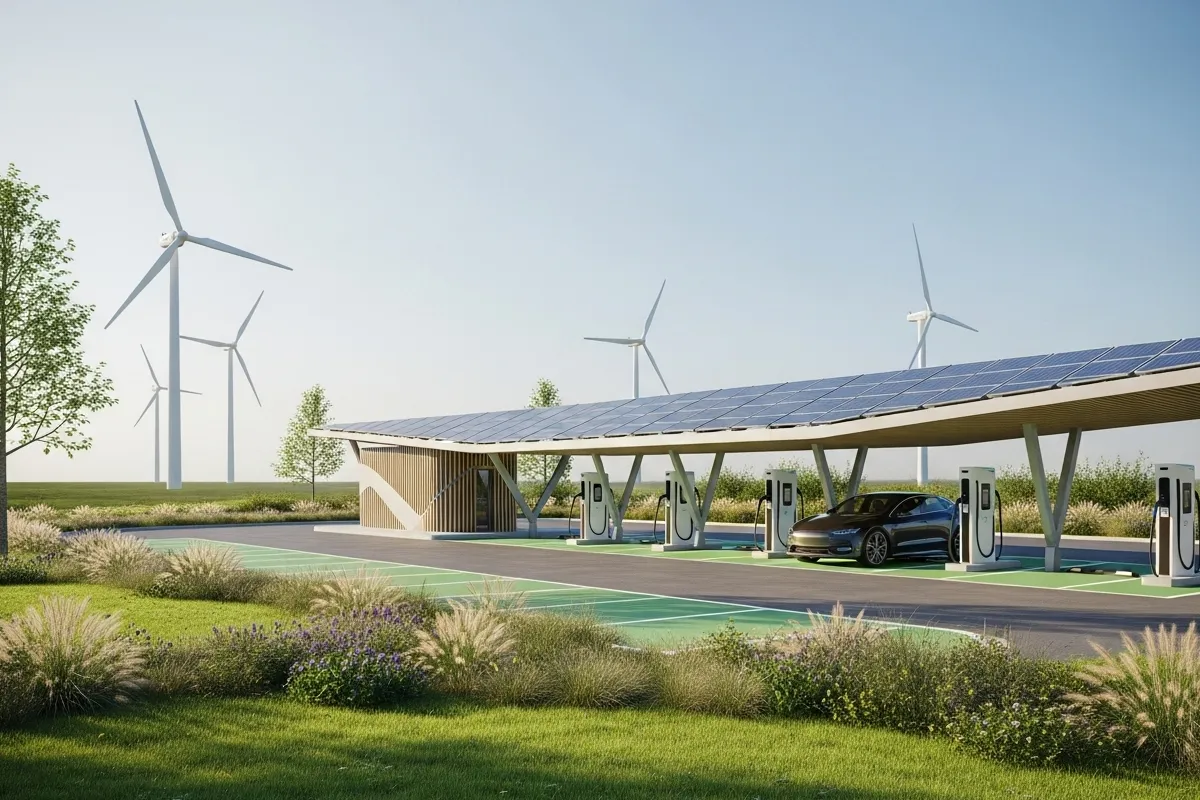Electric vehicles (EVs) have gained prominence as a sustainable alternative to traditional internal combustion engine vehicles, often marketed with the promise of being environmentally friendly. The common perception is that because they run on electricity rather than fossil fuels, they are inherently ‘clean’ or ‘zero-emission.’ However, this perception oversimplifies the environmental implications associated with electric vehicle technology. To truly understand their impact, one must examine the entire lifecycle of electric vehicles, from manufacturing to disposal.
The lifecycle of an electric vehicle comprises several stages, each presenting unique environmental concerns. At the outset, the manufacturing of EVs often involves the extraction and processing of raw materials, such as lithium, cobalt, and nickel, essential for their batteries. These processes can result in significant ecological disruption, pollution, and a considerable carbon footprint. Furthermore, the energy required for manufacturing can derive from non-renewable sources, thereby casting doubt on the overall environmental benefits of transitioning to electric mobility.
Once on the road, electric vehicles contribute to a reduction in greenhouse gas emissions during their operational phase when compared to their gasoline or diesel counterparts. However, the extent of these emissions depends heavily on the energy mix used to generate the electricity that powers them. In regions heavily reliant on coal or natural gas, the full ecological benefits of EVs can be diminished. Moreover, the importance of infrastructure development, including charging stations powered by renewable energy, cannot be overstated in assessing their sustainability.
The end-of-life stage for electric vehicles also warrants attention, as the disposal and recycling of batteries pose significant challenges and environmental risks. Consequently, a thorough exploration of electric vehicles must take into account these varied aspects. By engaging with the complete lifecycle, a clearer understanding of the true environmental impact of EVs can be ascertained, enabling more informed decisions related to their adoption and implementation in the pursuit of sustainable transportation solutions.
The Carbon Footprint of Battery Manufacturing
The production of electric vehicle (EV) batteries encompasses several significant stages, each contributing to the overall carbon footprint associated with battery manufacturing. A critical starting point in this lifecycle is mineral extraction, which includes the acquisition of lithium, cobalt, nickel, and other necessary components. The mining processes involved in extracting these minerals often generate considerable greenhouse gas emissions due to energy-intensive operations. For instance, lithium mining, particularly in regions like South America’s Lithium Triangle, has been shown to deplete significant water resources and disturb local ecosystems, further contributing to environmental degradation.
Following extraction, transportation plays an essential role in the carbon footprint of battery manufacturing. The minerals extracted are typically sent to processing facilities, sometimes located thousands of miles away from the mines. Transporting these raw materials, often by truck and ship, leads to additional fossil fuel consumption and associated emissions. According to various studies, transportation can account for up to 20% of total emissions from the mine to the finished battery, depending on the distances and modes of transport involved.
Once the necessary minerals reach manufacturing facilities, the actual production of battery cells begins. This phase is critically energy-intensive, relying on both electricity and thermal energy to produce high-performance batteries. The energy mix used during this manufacturing process can vary significantly. Facilities powered by renewable energy sources have a considerably lower carbon footprint than those dependent on fossil fuels, showcasing the importance of energy efficiency and cleaner technologies in reducing overall emissions. Overall, it is essential to recognize that while electric vehicles are often promoted as greener alternatives, the emissions associated with battery manufacturing must be carefully accounted for to truly assess their environmental impact. Understanding the carbon footprint across these stages informs the need for more sustainable practices within the battery production industry.

Environmental Impact Comparison: Electric Cars vs. Gas-Powered Cars
As electric vehicles (EVs) continue to gain popularity, understanding their environmental impact in comparison to traditional gas-powered cars becomes essential. Over a typical lifespan of 15 years, both vehicle types exhibit distinct differences in emissions, resource utilization, and overall ecological consequences.
In terms of greenhouse gas emissions, electric cars generally produce significantly lower lifetime emissions compared to their internal combustion engine counterparts. While the manufacturing process for EVs, particularly the production of lithium-ion batteries, contributes to initial emissions, their operational phase allows for reduced greenhouse gas output due to zero tailpipe emissions. Studies indicate that over 15 years, the total emissions from an electric car can be significantly less than that of a gasoline vehicle, often resulting in a reduction of up to 50% in greenhouse gases if the EV is charged with renewable energy sources.
Resource utilization also varies considerably between electric and gas-powered cars. The mining processes for materials needed in battery production—such as lithium, cobalt, and nickel—raise concerns about environmental degradation, human rights, and energy consumption. Conversely, gasoline vehicles depend primarily on fossil fuels, which not only lead to air pollution but also deplete natural resources and contribute to habitat destruction due to extraction activities. The shift towards electric vehicles necessitates improvements in sustainable mining practices and battery recycling to mitigate these impacts.
Lastly, potential environmental detriments present an important aspect to consider. While electric vehicles help in reducing urban air pollution and greenhouse gas emissions, the energy sources used for electricity generation play a critical role in determining the overall impact. Utilizing coal-fired power plants for charging can diminish the environmental benefits of EVs. Thus, the evolution towards a sustainable and clean energy grid is crucial. Each vehicle type presents unique challenges and benefits, highlighting the importance of informed choices and policy efforts in advancing transportation sustainability.
Challenges in Battery Recycling: Is It a Real Solution or a Future Problem?
The recycling of electric vehicle (EV) batteries has emerged as a crucial topic in discussions surrounding sustainability and environmental protection. As electric vehicle adoption continues to rise, so does the demand for effective recycling technologies that can address the challenges posed by spent batteries. Currently, lithium-ion batteries dominate the market; therefore, understanding the recycling landscape for these components is vital.
Current battery recycling technologies often involve mechanical and chemical processes to recover valuable materials such as lithium, cobalt, nickel, and manganese. However, these processes face several challenges. One significant issue is the economic viability of recycling operations. The initial investment in recycling facilities and the ongoing costs required to process batteries can deter investment. Additionally, fluctuations in the market prices for raw materials may impact the profitability of recycling endeavors.
Another challenge is the technical complexity associated with battery recycling. As EV batteries contain a variety of materials, the separation and purification processes can be labor-intensive and inefficient. Furthermore, the lack of standardization in battery designs complicates the recycling landscape, making it difficult for facilities to develop streamlined processes. This variation can lead to increased waste and a lower recovery rate for materials, undermining the environmental benefits of recycling.
In addition to the technical and economic hurdles, logistical challenges also play a significant role. Transportation and storage of used batteries pose safety risks, including potential fires caused by damaged or improperly handled batteries. As such, establishing safe and efficient logistics is critical for advancing recycling efforts.
Despite these challenges, battery recycling holds the promise of substantial benefits. By recovering raw materials, the lifecycle of batteries can be extended, reducing the need for new mining operations. However, it is essential to address the existing issues to ensure that recycling can be a viable solution rather than a source of future problems.

The Impact of Electricity Grids on Electric Vehicle Emissions
The emissions associated with electric vehicles (EVs) are frequently scrutinized, and a critical factor influencing these emissions is the source of electricity utilized to charge them. As the transition to electric mobility continues, understanding the electricity grids is vital to evaluating the overall environmental impact of EVs. The type of power plant supplying electricity can vary greatly, from coal-fired plants, which are known for their high emissions, to renewable sources such as wind, solar, and hydroelectric systems.
When charging an electric vehicle from a grid that relies predominantly on fossil fuels, primarily coal, the overall emissions can diminish the environmental benefits often associated with EVs. Coal-fired power plants release significant levels of carbon dioxide (CO2) and other pollutants, contributing to higher overall greenhouse gas emissions. Research indicates that in regions where coal is the primary energy source, the lifecycle emissions of electric vehicles can be comparable to those of conventional internal combustion engine vehicles. This context emphasizes the need for a deeper understanding of regional electricity sources and their contributions to emissions.
Conversely, when electric vehicles are charged using renewable energy sources, the emissions associated with their operation drop considerably. The lifecycle assessment in such scenarios shows an overwhelming reduction in carbon footprints, highlighting the advantages of clean energy integration in the grid. States and regions committed to renewable energy infrastructure typically see the benefits reflected in the reduced emissions profile of electric vehicles charged within their jurisdictions. The differentiation between fossil fuel and renewable electricity not only impacts the emissions linked to charging but is also a crucial aspect of sustainable transportation strategies.
Ultimately, the effectiveness of electric vehicles in reducing overall emissions relies significantly on the electricity grid from which they draw power. As the push towards decarbonizing energy sources increases, understanding this dynamic becomes essential for evaluating the true environmental benefits of electric vehicle adoption in various regions.
Innovations in Sustainable Battery Technology
The demand for electric vehicles (EVs) continues to rise, driving innovation in sustainable battery technology to ensure their production, usage, and recycling have minimal environmental impact. As a key component of EVs, batteries are pivotal not only in determining the vehicle’s performance but also its ecological footprint. Thus, advancements in battery chemistry, alternative materials, and eco-friendly manufacturing processes play an essential role in promoting sustainability throughout the lifecycle of these vehicles.
Recent developments in battery chemistry have led to the exploration of lithium-sulfur and solid-state batteries, which offer the potential for greater energy density and reduced dependency on metals that are often mined in environmentally damaging ways. Lithium-sulfur batteries could significantly reduce the carbon footprint associated with battery production by utilizing more abundant and less environmentally impactful materials. Conversely, solid-state batteries are designed to replace liquid electrolytes with solid materials, enhancing safety and longevity while reducing the risk of leakage and hazardous waste.
Alternative materials are also gaining traction as researchers seek to alleviate the environmental impact of traditional lithium-ion batteries. The incorporation of organic compounds, sodium, and magnesium as more sustainable alternatives to lithium could lead to more responsible sourcing strategies and decreased reliance on raw materials that contribute to ecological degradation.
Moreover, innovations in recycling processes are crucial to improving the sustainability of batteries. New methods, such as direct recycling and bioleaching, are being developed to recover valuable materials from used batteries more efficiently, significantly diminishing waste and lowering the extraction impact on the environment. Such processes not only enable the circular economy but also reduce the need for new raw material extraction, thereby lessening the overall environmental footprint of electric vehicles.
In conclusion, advancements in sustainable battery technology are instrumental in shaping the future of electric vehicles. By focusing on greener materials, improved battery chemistry, and responsible recycling processes, the automotive industry can dramatically reduce its environmental impact, ensuring that the shift towards electric mobility aligns with broader sustainability goals.

Consumer Choices: Understanding the Bigger Picture
The electric vehicle (EV) market is rapidly evolving, and consumer choices play a pivotal role in shaping its future. As demand for electric vehicles grows, it is essential for consumers to look beyond the immediate benefits of owning an EV and consider the full lifecycle impact of their vehicle purchases. This means evaluating not only the environmental benefits of reduced tailpipe emissions but also the broader implications associated with manufacturing, energy consumption, and end-of-life disposal.
To make informed decisions, consumers should start by researching the materials used in the production of electric vehicles. Many EVs rely on components that require the mining of minerals like lithium, cobalt, and nickel. Understanding the sourcing of these materials is crucial, as the extraction processes can have significant environmental and social impacts. By prioritizing manufacturers who use ethically sourced materials and invest in sustainable mining practices, consumers can encourage greater accountability in the industry.
Additionally, assessing the energy sources that power the vehicles during their operation is vital. Electric vehicles are only as green as the electricity that charges them. Consumers can advocate for clean energy solutions by supporting local initiatives that promote renewable energy infrastructure. This not only increases the sustainability of electric vehicles but also reduces reliance on fossil fuels in the grid, illustrating the interconnectedness of consumer choices and environmental impact.
Moreover, consumers should consider the vehicle’s end-of-life options. Many EV batteries face challenges regarding recycling and disposal. By choosing brands that offer comprehensive take-back programs or innovative recycling solutions, consumers can contribute to a more circular economy. Such choices help reduce waste and promote sustainable practices across the automotive sector. Ultimately, informed consumer choices empower individuals to influence the electric vehicle market and promote a greener future.
Policies and Regulations Shaping Electric Vehicle Sustainability
The landscape of electric vehicle (EV) sustainability is significantly influenced by a myriad of government policies and regulations designed to promote environmentally friendly practices within the automotive sector. These regulations serve multiple purposes, including incentivizing the adoption of electric vehicles, establishing emissions standards, and promoting the development of supporting infrastructure. Through the implementation of various initiatives, governments worldwide seek to facilitate a transition from traditional fossil fuel-powered vehicles to electric alternatives.
One notable initiative is the introduction of tax credits and rebates for consumers who purchase electric vehicles. These financial incentives can reduce the initial cost, making EVs more accessible to a broader audience. Additionally, many governments are mandating that automakers increase their production of electric models and reduce reliance on internal combustion engines. This legislative push directly impacts the automotive industry, spurring innovation and encouraging manufacturers to invest in sustainable technologies.
Furthermore, regulations on emissions standards play a crucial role in shaping the automotive landscape. By setting stringent guidelines for greenhouse gas emissions, governments aim to limit the environmental impact of vehicles throughout their lifecycle. Stakeholders in the industry must navigate these evolving regulations, adapting their strategies to comply with legally binding targets. The pressure to achieve sustainability goals not only motivates companies to improve their product offerings but also encourages investment in green technologies such as battery recycling and alternative energy sources.
While the direction of current policies appears to support a transition towards sustainable transportation, the future landscape will be defined by proposed legislative measures. With ongoing discussions around carbon pricing mechanisms and stricter emissions targets, the regulations adopted today are likely to influence the development of electric vehicles for years to come. The interplay between government actions and industry responses ultimately shapes the trajectory of electric vehicle sustainability, determining both the environmental benefits and economic viability of this critical sector.
Conclusion: A Comprehensive View of Electric Vehicles
In summarizing the insights gained throughout this exploration of electric vehicles (EVs), it is evident that they offer notable environmental benefits compared to traditional gasoline-powered cars. The shift towards electric mobility has the potential to significantly reduce greenhouse gas emissions, particularly when the electricity that powers these vehicles comes from renewable sources. However, it is also crucial to recognize the complexities and challenges associated with the full lifecycle of EVs. From battery production and raw material extraction to end-of-life management, each stage presents its own set of environmental concerns.
The production of EV batteries, for instance, often relies on minerals such as lithium, cobalt, and nickel, which can result in ecological degradation if not sourced responsibly. The manufacturing and recycling processes are equally impactful on the environment, emphasizing the need for improved practices and innovative technologies that minimize harm and enhance sustainability. Furthermore, while electric vehicles themselves produce no tailpipe emissions, the sources of energy that link to their overall carbon footprint must be scrutinized and diversified.
Given these findings, it is imperative that the EV industry remains committed to transparency and ethical practices. Continuous research and innovation will play a vital role in addressing the challenges inherent in electric vehicle production and use. With focused efforts on developing cleaner energy sources and robust recycling systems, there is potential to alleviate some of the negative consequences currently associated with EV lifecycles. Therefore, promoting awareness about these challenges while advocating for sustainable solutions is paramount for shaping a future where electric vehicles contribute positively to environmental health.




